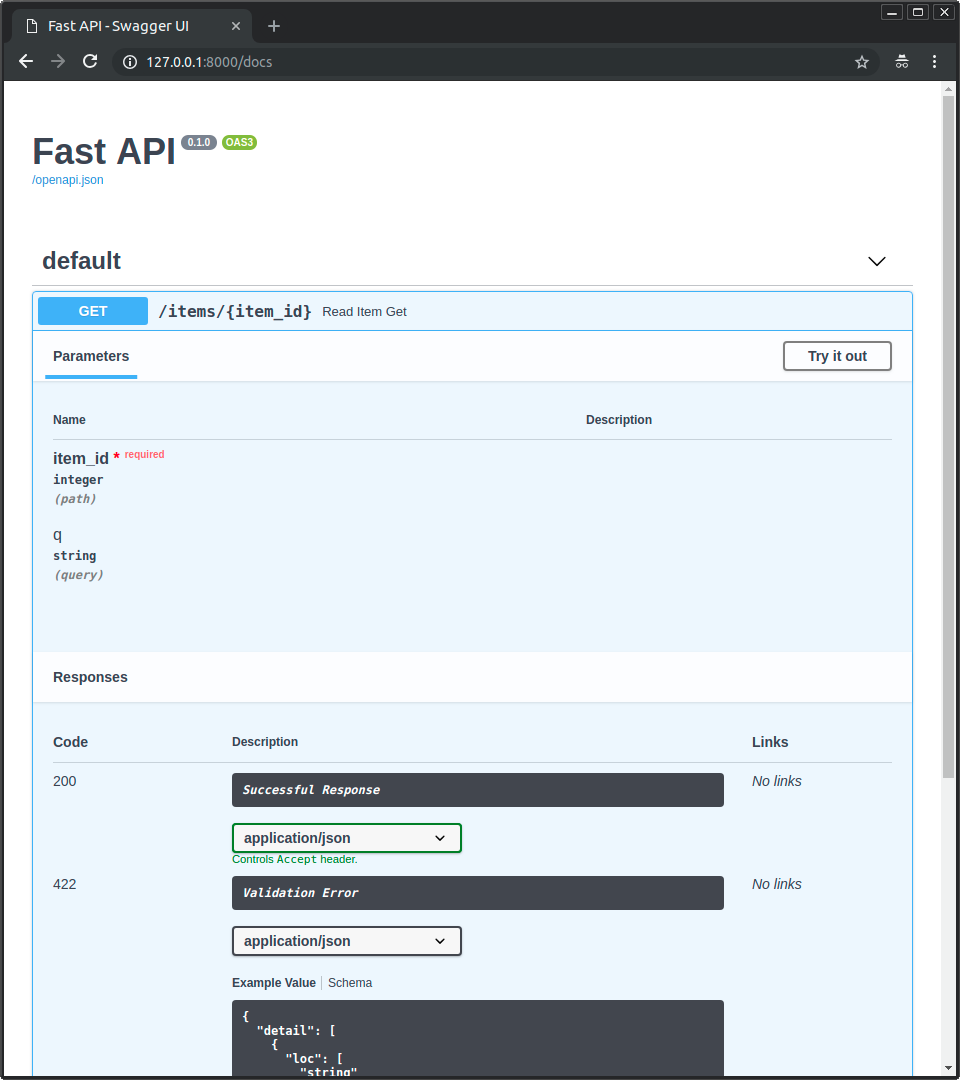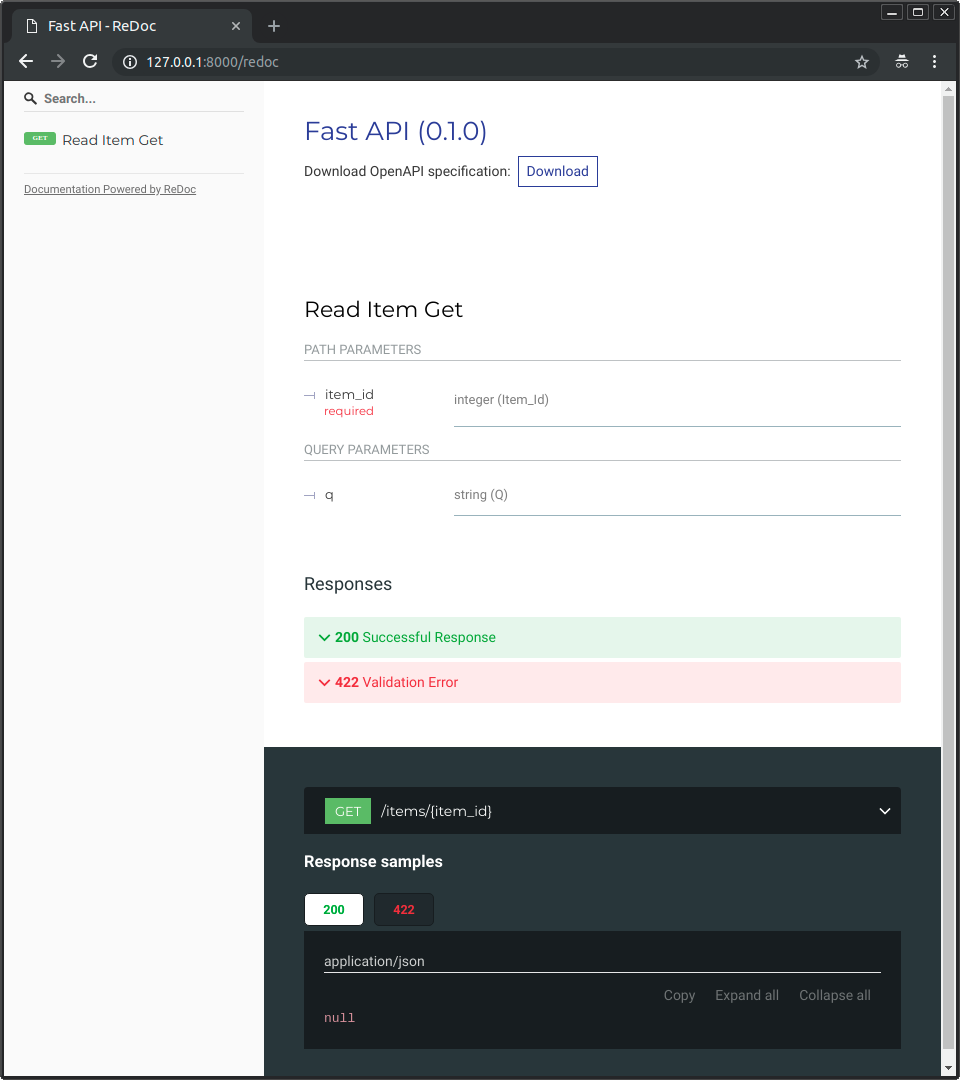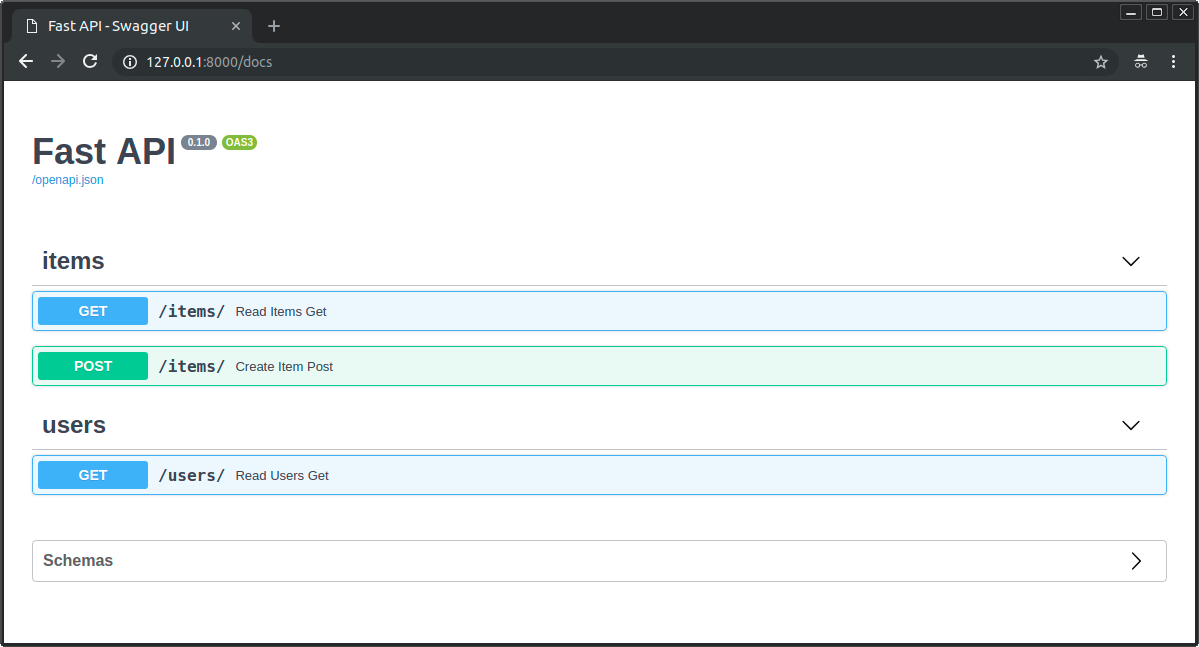fastapi
fastapi

FastAPI 是一个用于构建 API 的现代、快速(高性能)的 web 框架,使用 Python 3.6+ 并基于标准的 Python 类型提示。
关键特性:
- 快速:可与 NodeJS 和 Go 比肩的极高性能(归功于 Starlette 和 Pydantic)。最快的 Python web 框架之一。
- 高效编码:提高功能开发速度约 200% 至 300%。*
- 更少 bug:减少约 40% 的人为(开发者)导致错误。*
- 智能:极佳的编辑器支持。处处皆可自动补全,减少调试时间。
- 简单:设计的易于使用和学习,阅读文档的时间更短。
- 简短:使代码重复最小化。通过不同的参数声明实现丰富功能。bug 更少。
- 健壮:生产可用级别的代码。还有自动生成的交互式文档。
- 标准化:基于(并完全兼容)API 的相关开放标准:OpenAPI (以前被称为 Swagger) 和JSON Schema
文档: https://fastapi.tiangolo.com
源码: https://github.com/tiangolo/fastapi
第一步
- 安装fastapi
pip install fastapi
- 安装
uvicorn来作为服务器:
pip install "uvicorn[standard]"
最简单fastapi程序
from fastapi import FastAPI app = FastAPI() @app.get("/") async def root(): return {"message": "Hello World"}
uvicorn main:app --reload
自带文档
http://127.0.0.1:8000/docs

http://127.0.0.1:8000/redoc

路径参数
from fastapi import FastAPI app = FastAPI() @app.get("/items/{item_id}") async def read_item(item_id: int): return {"item_id": item_id}
浏览器访问 http://127.0.0.1:8000/items/3
响应:
{"item_id":3}
浏览器访问http://127.0.0.1:8000/items/foo
响应
{ "detail": [ { "loc": [ "path", "item_id" ], "msg": "value is not a valid integer", "type": "type_error.integer" } ] }
因为路径参数 item_id 传入的值为 "foo",它不是一个 int。
查询参数
声明不属于路径参数的其他函数参数时,它们将被自动解释为"查询字符串"参数
from fastapi import FastAPI app = FastAPI() @app.get("/items/") async def read_item(skip: int = 0, limit: int = 10): return {"skip":skip}
浏览器访问http://127.0.0.1:8000/items/?skip=0&limit=10
响应:
{"skip":0,"limit":10}
浏览器访问127.0.0.1:8000/items?skip=0&limit=10.1
响应:
{"detail": [ { "loc": ["query", "limit"], "msg": "value is not a valid integer", "type": "type_error.integer" } ] }
请求参数
from typing import Union from fastapi import FastAPI from pydantic import BaseModel class Item(BaseModel): name: str price: float tax: Union[float, None] = None app = FastAPI() @app.post("/items") async def create_item(item: Item): return item
请求http://127.0.0.1:8000/items 请求类型post 参数:{ "name":"yyc", "price":99.0, "tax":18.8 }
响应:
{ "name": "yyc", "price": 99.0, "tax": 18.8 }
请求http://127.0.0.1:8000/items 请求类型post 参数:{ "name":"yyc" }
响应:
{ "detail": [ { "loc": [ "body", "price" ], "msg": "field required", "type": "value_error.missing" } ] }
多个参数
from typing import Union from fastapi import FastAPI, Body from pydantic import BaseModel app = FastAPI() class Item(BaseModel): name: str description: Union[str, None] = None price: float tax: Union[float, None] = None class User(BaseModel): username: str full_name: Union[str, None] = None @app.put("/items/{item_id}") async def update_item(item_id: int, user: User, item: Item, importance: int = Body(), q: Union[str, None] = None): results = {"item_id": item_id, "item": item, "user": user, "importance": importance, "q": q} return results
嵌套字段
from typing import Set, Union from fastapi import FastAPI from pydantic import BaseModel app = FastAPI() class Image(BaseModel): url: str name: str class Item(BaseModel): name: str description: Union[str, None] = None price: float tax: Union[float, None] = None tags: Set[str] = set() image: Union[Image, None] = None @app.put("/items/{item_id}") async def update_item(item_id: int, item: Item): results = {"item_id": item_id, "item": item} return results
请求体 + 路径参数
from typing import Union from fastapi import FastAPI from pydantic import BaseModel class Item(BaseModel): name: str description: Union[str, None] = None price: float tax: Union[float, None] = None app = FastAPI() @app.put("/items/{item_id}") async def create_item(item_id: int, item: Item): return {"item_id": item_id, **item.dict()}
请求: http://127.0.0.1:8000/items/1 post请求
请求参数:
{ "name":"yyc","price":99.0, "description": "这个nb","tax":18.8 }
响应:
{ "item_id": 1, "name": "yyc", "description": "这个人nb", "price": 99.0, "tax": 18.8 }
请求体 + 路径参数 + 查询参数
from typing import Union from fastapi import FastAPI from pydantic import BaseModel class Item(BaseModel): name: str description: Union[str, None] = None price: float tax: Union[float, None] = None app = FastAPI() @app.put("/items/{item_id}") async def create_item(item_id: int, item: Item, q: Union[str, None] = None): result = {"item_id": item_id, **item.dict()} if q: result.update({"q": q}) return result
请求http://127.0.0.1:8000/items/1?q=yyc put请求
请求参数:
{ "name":"yyc", "price":99.0, "description": "这个人nb", "tax":18.8 }
响应:
{ "item_id": 1, "name": "yyc", "description": "这个人nb", "price": 99.0, "tax": 18.8, "q": "yyc" }
文件上传
pip install python-multipart
案例:
from fastapi import FastAPI, File, UploadFile app = FastAPI() @app.post("/files/") async def create_file(file: bytes = File()): return {"file_size": len(file)} @app.post("/uploadfile/") async def create_upload_file(file: UploadFile): return {"filename": file.filename}
from typing import Union from fastapi import FastAPI, File, UploadFile app = FastAPI() @app.post("/files/") async def create_file(file: Union[bytes, None] = File(default=None)): if not file: return {"message": "No file sent"} else: return {"file_size": len(file)} @app.post("/uploadfile/") async def create_upload_file(file: Union[UploadFile, None] = None): if not file: return {"message": "No upload file sent"} else: return {"filename": file.filename}
多文件上传
3.8版本即以上
from typing import List from fastapi import FastAPI, File, UploadFile from fastapi.responses import HTMLResponse app = FastAPI() @app.post("/files/") async def create_files(files: List[bytes] = File()): return {"file_sizes": [len(file) for file in files]} @app.post("/uploadfiles/") async def create_upload_files(files: List[UploadFile]): return {"filenames": [file.filename for file in files]} @app.get("/") async def main(): content = """ <body> <form action="/files/" enctype="multipart/form-data" method="post"> <input name="files" type="file" multiple> <input type="submit"> </form> <form action="/uploadfiles/" enctype="multipart/form-data" method="post"> <input name="files" type="file" multiple> <input type="submit"> </form> </body> """ return HTMLResponse(content=content)
3.9版本即以上
from fastapi import FastAPI, File, UploadFile from fastapi.responses import HTMLResponse app = FastAPI() @app.post("/files/") async def create_files(files: list[bytes] = File()): return {"file_sizes": [len(file) for file in files]} @app.post("/uploadfiles/") async def create_upload_files(files: list[UploadFile]): return {"filenames": [file.filename for file in files]} @app.get("/") async def main(): content = """ <body> <form action="/files/" enctype="multipart/form-data" method="post"> <input name="files" type="file" multiple> <input type="submit"> </form> <form action="/uploadfiles/" enctype="multipart/form-data" method="post"> <input name="files" type="file" multiple> <input type="submit"> </form> </body> """ return HTMLResponse(content=content)
参数校验
查询参数
from typing import Union from fastapi import FastAPI, Query app = FastAPI() @app.get("/items/") # q 的值为str类型或为none 默认值为none 最小长度3,最大长度50 支持正则匹配 async def read_items( q: Union[str, None] = Query( default=None, min_length=3, max_length=50, regex="^fixedquery$" ) ): results = {"items": [{"item_id": "Foo"}, {"item_id": "Bar"}]} if q: results.update({"q": q}) return results
路径参数
from fastapi import FastAPI, Path, Query app = FastAPI() @app.get("/items/{item_id}") async def read_items( *, item_id: int = Path(title="The ID of the item to get", ge=0, le=1000), q: str, size: float = Query(gt=0, lt=10.5) ): results = {"item_id": item_id} if q: results.update({"q": q}) return results
gt:大于ge:大于等于lt:小于le:小于等于
Cookie 参数
from typing import Union from fastapi import Cookie, FastAPI app = FastAPI() @app.get("/items/") async def read_items(ads_id: Union[str, None] = Cookie(default=None)): return {"ads_id": ads_id}
设置cookie
from fastapi import FastAPI, Response app = FastAPI() @app.post("/cookie-and-object/") def create_cookie(response: Response): response.set_cookie(key="fakesession", value="fake-cookie-session-value") return {"message": "Come to the dark side, we have cookies"}
header参数
from typing import Union from fastapi import FastAPI, Header app = FastAPI() @app.get("/items/") async def read_items(user_agent: Union[str, None] = Header(default=None)): return {"User-Agent": user_agent}
响应
{"User-Agent":"Mozilla/5.0 (Windows NT 10.0; Win64; x64) AppleWebKit/537.36 (KHTML, like Gecko) Chrome/108.0.0.0 Safari/537.36 Edg/108.0.1462.54"}
from typing import List, Union from fastapi import FastAPI, Header app = FastAPI() @app.get("/items/") async def read_items(x_token: Union[List[str], None] = Header(default=None)): return {"X-Token values": x_token}
header:
X-Token: foo X-Token: bar
响应:
{ "X-Token values": [ "bar", "foo" ] }
request
request.base_url # 获取baseurl request.url # 获取请求路径 request.url.path # 获取path request.headers # 获取请求头
响应模型
你可以在任意的路径操作中使用 response_model 参数来声明用于响应的模型:
from typing import List, Union from fastapi import FastAPI from pydantic import BaseModel app = FastAPI() class Item(BaseModel): name: str description: Union[str, None] = None price: float tax: Union[float, None] = None tags: List[str] = [] @app.post("/items/", response_model=Item) # 规定返回响应的类型必须是Item类型 async def create_item(item: Item): return item
当响应参数中 有多余参数时不返回
from typing import Union from fastapi import FastAPI from pydantic import BaseModel, EmailStr app = FastAPI() class UserIn(BaseModel): username: str password: str email: EmailStr full_name: Union[str, None] = None class UserOut(BaseModel): username: str email: EmailStr full_name: Union[str, None] = None @app.post("/user/", response_model=UserOut) async def create_user(user: UserIn): return user
请求http://127.0.0.1:8000/user/ post 请求
请求参数
{ "username":"yyc", "password":"123456", "email":"1093565279@qq.com", "full_name":"杨爸爸" }
响应:
{ "username": "yyc", "email": "1093565279@qq.com", "full_name": "杨爸爸" }
状态码
from fastapi import FastAPI, status app = FastAPI() @app.post("/items/", status_code=status.HTTP_201_CREATED) async def create_item(name: str): return {"name": name}
from fastapi import FastAPI app = FastAPI() @app.post("/items/", status_code=201) async def create_item(name: str): return {"name": name}
表单数据
from fastapi import FastAPI, Form app = FastAPI() @app.post("/login/") async def login(username: str = Form(), password: str = Form()): return {"username": username}
异常处理
from fastapi import FastAPI, HTTPException app = FastAPI() items = {"foo": "The Foo Wrestlers"} @app.get("/items-header/{item_id}") async def read_item_header(item_id: str): if item_id not in items: raise HTTPException( status_code=404, detail="Item not found", headers={"X-Error": "There goes my error"}, ) return {"item": items[item_id]}
自定义异常处理
from fastapi import FastAPI, Request from fastapi.responses import JSONResponse class UnicornException(Exception): def __init__(self, name: str): self.name = name app = FastAPI() @app.exception_handler(UnicornException) async def unicorn_exception_handler(request: Request, exc: UnicornException): return JSONResponse( status_code=418, content={"message": f"Oops! {exc.name} did something. There goes a rainbow..."}, ) @app.get("/unicorns/{name}") async def read_unicorn(name: str): if name == "yolo": raise UnicornException(name=name) return {"unicorn_name": name}
请求 /unicorns/yolo 时,路径操作会触发 UnicornException。
但该异常将会被 unicorn_exception_handler 处理。
接收到的错误信息清晰明了,HTTP 状态码为 418,JSON 内容如下:
{"message": "Oops! yolo did something. There goes a rainbow..."}
覆盖请求验证异常
请求中包含无效数据时,FastAPI 内部会触发 RequestValidationError。
该异常也内置了默认异常处理器。
覆盖默认异常处理器时需要导入 RequestValidationError,并用 @app.excption_handler(RequestValidationError) 装饰异常处理器。
这样,异常处理器就可以接收 Request 与异常。
from fastapi import FastAPI, HTTPException from fastapi.exceptions import RequestValidationError from fastapi.responses import PlainTextResponse from starlette.exceptions import HTTPException as StarletteHTTPException app = FastAPI() @app.exception_handler(StarletteHTTPException) async def http_exception_handler(request, exc): return PlainTextResponse(str(exc.detail), status_code=exc.status_code) @app.exception_handler(RequestValidationError) async def validation_exception_handler(request, exc): return PlainTextResponse(str(exc), status_code=400) @app.get("/items/{item_id}") async def read_item(item_id: int): if item_id == 3: raise HTTPException(status_code=418, detail="Nope! I don't like 3.") return {"item_id": item_id}
访问 /items/foo,可以看到以下内容替换了默认 JSON 错误信息:
{ "detail": [ { "loc": [ "path", "item_id" ], "msg": "value is not a valid integer", "type": "type_error.integer" } ] }
以下是文本格式的错误信息:
1 validation error for Request path -> item_id value is not a valid integer (type=type_error.integer)
更多异常处理:
https://fastapi.tiangolo.com/zh/tutorial/handling-errors/
标签
from typing import Set, Union from fastapi import FastAPI from pydantic import BaseModel app = FastAPI() class Item(BaseModel): name: str description: Union[str, None] = None price: float tax: Union[float, None] = None tags: Set[str] = set() @app.post("/items/", response_model=Item, tags=["items"]) async def create_item(item: Item): return item @app.get("/items/", tags=["items"]) async def read_items(): return [{"name": "Foo", "price": 42}] @app.get("/users/", tags=["users"]) async def read_users(): return [{"username": "johndoe"}]

路由参数
summary 和 description 参数
from typing import Set, Union from fastapi import FastAPI from pydantic import BaseModel app = FastAPI() class Item(BaseModel): name: str description: Union[str, None] = None price: float tax: Union[float, None] = None tags: Set[str] = set() @app.post( "/items/", response_model=Item, summary="Create an item", description="Create an item with all the information, name, description, price, tax and a set of unique tags", ) async def create_item(item: Item): return item
json转换
在某些情况下,您可能需要将数据类型(如Pydantic模型)转换为与JSON兼容的数据类型(如dict、list等)。
比如,如果您需要将其存储在数据库中。
对于这种要求, FastAPI提供了jsonable_encoder()函数。
3.6及以上
from datetime import datetime from typing import Union from fastapi import FastAPI from fastapi.encoders import jsonable_encoder from pydantic import BaseModel fake_db = {} class Item(BaseModel): title: str timestamp: datetime description: Union[str, None] = None app = FastAPI() @app.put("/items/{id}") def update_item(id: str, item: Item): json_compatible_item_data = jsonable_encoder(item) fake_db[id] = json_compatible_item_data
3.10及以上
from datetime import datetime from fastapi import FastAPI from fastapi.encoders import jsonable_encoder from pydantic import BaseModel fake_db = {} class Item(BaseModel): title: str timestamp: datetime description: str | None = None app = FastAPI() @app.put("/items/{id}") def update_item(id: str, item: Item): json_compatible_item_data = jsonable_encoder(item) fake_db[id] = json_compatible_item_data
中间件
import time from fastapi import FastAPI, Request app = FastAPI() @app.middleware("http") async def add_process_time_header(request: Request, call_next): start_time = time.time() response = await call_next(request) # 获取响应 process_time = time.time() - start_time response.headers["X-Process-Time"] = str(process_time) return response
cors跨域
allow_origins- 一个允许跨域请求的源列表。例如['https://example.org', 'https://www.example.org']。你可以使用['*']允许任何源。allow_origin_regex- 一个正则表达式字符串,匹配的源允许跨域请求。例如'https://.*\.example\.org'。allow_methods- 一个允许跨域请求的 HTTP 方法列表。默认为['GET']。你可以使用['*']来允许所有标准方法。allow_headers- 一个允许跨域请求的 HTTP 请求头列表。默认为[]。你可以使用['*']允许所有的请求头。Accept、Accept-Language、Content-Language以及Content-Type请求头总是允许 CORS 请求。allow_credentials- 指示跨域请求支持 cookies。默认是False。另外,允许凭证时allow_origins不能设定为['*'],必须指定源。expose_headers- 指示可以被浏览器访问的响应头。默认为[]。max_age- 设定浏览器缓存 CORS 响应的最长时间,单位是秒。默认为600。
from fastapi import FastAPI from fastapi.middleware.cors import CORSMiddleware app = FastAPI() origins = [ "http://localhost.tiangolo.com", "https://localhost.tiangolo.com", "http://localhost", "http://localhost:8080", ] app.add_middleware( CORSMiddleware, allow_origins=origins, allow_credentials=True, allow_methods=["*"], allow_headers=["*"], ) @app.get("/") async def main(): return {"message": "Hello World"}
ApiRouter
如果你正在开发一个应用程序或 Web API,很少会将所有的内容都放在一个文件中。
FastAPI 提供了一个方便的工具,可以在保持所有灵活性的同时构建你的应用程序。
controllers/user.py
from fastapi import APIRouter router = APIRouter(prefix="/user", tags=["user"]) @router.get("/{user_id}") def getUser(user_id: int): return { "user_id":user_id }
main.py
from fastapi import FastAPI from controllers import user app = FastAPI() app.include_router(user.router)
响应:
{ "user_id":1 }
websocket
pip install websockets
from fastapi import FastAPI, WebSocket from fastapi.responses import HTMLResponse app = FastAPI() html = """ <!DOCTYPE html> <html> <head> <title>Chat</title> </head> <body> <h1>WebSocket Chat</h1> <form action="" onsubmit="sendMessage(event)"> <input type="text" id="messageText" autocomplete="off"/> <button>Send</button> </form> <ul id='messages'> </ul> <script> var ws = new WebSocket("ws://localhost:8000/ws"); ws.onmessage = function(event) { var messages = document.getElementById('messages') var message = document.createElement('li') var content = document.createTextNode(event.data) message.appendChild(content) messages.appendChild(message) }; function sendMessage(event) { var input = document.getElementById("messageText") ws.send(input.value) input.value = '' event.preventDefault() } </script> </body> </html> """ @app.get("/") async def get(): return HTMLResponse(html) @app.websocket("/ws") async def websocket_endpoint(websocket: WebSocket): await websocket.accept() while True: data = await websocket.receive_text() await websocket.send_text(f"Message text was: {data}")
from typing import Union from fastapi import ( Cookie, Depends, FastAPI, Query, WebSocket, WebSocketException, status, ) from fastapi.responses import HTMLResponse app = FastAPI() html = """ <!DOCTYPE html> <html> <head> <title>Chat</title> </head> <body> <h1>WebSocket Chat</h1> <form action="" onsubmit="sendMessage(event)"> <label>Item ID: <input type="text" id="itemId" autocomplete="off" value="foo"/></label> <label>Token: <input type="text" id="token" autocomplete="off" value="some-key-token"/></label> <button onclick="connect(event)">Connect</button> <hr> <label>Message: <input type="text" id="messageText" autocomplete="off"/></label> <button>Send</button> </form> <ul id='messages'> </ul> <script> var ws = null; function connect(event) { var itemId = document.getElementById("itemId") var token = document.getElementById("token") ws = new WebSocket("ws://localhost:8000/items/" + itemId.value + "/ws?token=" + token.value); ws.onmessage = function(event) { var messages = document.getElementById('messages') var message = document.createElement('li') var content = document.createTextNode(event.data) message.appendChild(content) messages.appendChild(message) }; event.preventDefault() } function sendMessage(event) { var input = document.getElementById("messageText") ws.send(input.value) input.value = '' event.preventDefault() } </script> </body> </html> """ @app.get("/") async def get(): return HTMLResponse(html) async def get_cookie_or_token( websocket: WebSocket, session: Union[str, None] = Cookie(default=None), token: Union[str, None] = Query(default=None), ): if session is None and token is None: raise WebSocketException(code=status.WS_1008_POLICY_VIOLATION) return session or token @app.websocket("/items/{item_id}/ws") async def websocket_endpoint( websocket: WebSocket, item_id: str, q: Union[int, None] = None, cookie_or_token: str = Depends(get_cookie_or_token), ): await websocket.accept() while True: data = await websocket.receive_text() await websocket.send_text( f"Session cookie or query token value is: {cookie_or_token}" ) if q is not None: await websocket.send_text(f"Query parameter q is: {q}") await websocket.send_text(f"Message text was: {data}, for item ID: {item_id}")




【推荐】编程新体验,更懂你的AI,立即体验豆包MarsCode编程助手
【推荐】凌霞软件回馈社区,博客园 & 1Panel & Halo 联合会员上线
【推荐】抖音旗下AI助手豆包,你的智能百科全书,全免费不限次数
【推荐】博客园社区专享云产品让利特惠,阿里云新客6.5折上折
【推荐】轻量又高性能的 SSH 工具 IShell:AI 加持,快人一步
· 在鹅厂做java开发是什么体验
· 百万级群聊的设计实践
· WPF到Web的无缝过渡:英雄联盟客户端的OpenSilver迁移实战
· 永远不要相信用户的输入:从 SQL 注入攻防看输入验证的重要性
· 浏览器原生「磁吸」效果!Anchor Positioning 锚点定位神器解析